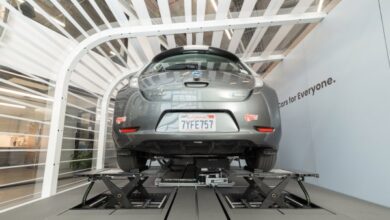10 investors predict MaaS, on-demand delivery and EVs will dominate mobility’s post-pandemic future – TechCrunch

[ad_1]
The COVID-19 pandemic didn’t just upend the transportation industry. It laid bare its weaknesses, and conversely, uncovered potential opportunities.
Electric bikes sales spiked as public transit ridership evaporated. The public, and investors, began to recognize the utility of autonomous sidewalk delivery bots, which had once been viewed as mere novelties; the rising popularity of on-demand delivery prompted major retailers like Walmart to put more resources towards meeting consumers needs and was one of the driving forces behind Uber’s decision to dump nearly every business unit and acquire Postmates.
The upshot? The transformation isn’t over. Following up on our May of 2020 survey of the sector and about the impact of COVID-19 in particular, TechCrunch spoke with 10 investors about the state of mobility, which trends they’re most excited about and what they’re looking for in their next investments. They see opportunities within software, particularly around mobility-as-a-service ventures and fleet management, continued demand for delivery and the push for electrification and batteries as well as the financial instrument — SPACs — that so many startups turned to in 2020. But there’s a lot more; they even see tailwinds for eVTOLs.
Here’s who we interviewed:
- Clara Brenner, co-founder and managing partner, Urban Innovation Fund
- Shawn Carolan, partner, Menlo Ventures
- Dave Clark, partner, Expa
- Abhijit Ganguly, senior manager, Goodyear Ventures
- Rachel Holt, co-founder and general partner, Construct Capital
- David Lawee, founder and general partner, CapitalG
- Sasha Ostojic, operating partner, Playground Global
- Sebastian Peck, managing director, InMotion Ventures
- Natalia Quintero and Rachel Haot, Transit Innovation Partnership/Transit Tech Lab
Clara Brenner, co-founder and managing partner, Urban Innovation Fund
COVID-19 disrupted virtually every sector of the transportation industry. E-bike demand spiked, shared scooters initially struggled with some rebounding, ridership dwindled in ride-hailing and plummeted in public transit as consumers turned to cars and other alternatives. Meanwhile, demand for delivery skyrocketed and the autonomous vehicle industry went through a consolidation. What sectors will recover in 2021 and where are the new and unlikely opportunities to invest?
COVID has exposed how rickety, insolvent and inequitable transit is in the U.S. Tools that empower cities to get compensated for private enterprise monetizing public infrastructure, and that ensure more equitable mobility access are exciting to me. Companies like Ride Report that help cities wrap their arms around all of the various public and private transit happening on their streets are exciting to me.
What are the remaining opportunities for new startups, now that the autonomous vehicle industry is maturing with unprecedented consolidation, billion-dollar funding rounds and even a few low-volume commercial operations kicking off?
Autonomous vehicles still have a long way to go, and there is still lots of room for new startups to make their mark on this space. In particular, we’ve been interested to see new entrants working on software tools to facilitate regulation and parking.
What are the overlooked areas that you want to invest in, now that legacy automakers are shifting their portfolios to electric and new EV manufacturers are preparing to start production?
We are very interested in the emerging fleet management space — and this is reflected in a number of our recent investments, including Electriphi (software to help fleets transition to electric) and Kyte (activating underutilized fleets to deliver a magical car rental experience). There are so many efficiencies that come from the fleet model for transportation — we think this will be an increasingly important area in the coming years.
What is the fundraising model of success for transportation startups of the future? Do you expect early-stage funding in this sector to stay hot indefinitely? Do you see SPACs as the path to liquidity long term for a large number of startups in this sector?
Transportation is important to basically all people and is a real mess, so it will likely continue to be a hot topic and a source of investor interest for years to come. However, for capital intensive transportation companies, the rounds have gotten so huge and expensive that they often make little sense for early-stage funders to participate in (they get diluted down hugely). Not that this seems to be dissuading many investors at the moment.
At the Urban Innovation Fund, we are spending a lot of time looking at software tools that enable larger hardware systems to work more efficiently. In terms of longer-term liquidity, SPACs represent a good option for many companies. That said, consolidation/mergers seems the most logical outcome for most companies in the transportation space — where strategic partnerships and integrations represent critical competitive advantages.
What do you want to see from the Biden administration to accelerate innovation in the transportation sector?
I’d like to see the Biden administration invest in our urban public transit systems — we know those systems can work beautifully. This may not accelerate “innovation,” but it will accelerate progress. This is a fundamental confusion in the VC space — innovation does not always equal progress.
Shawn Carolan, partner, Menlo Ventures
COVID-19 disrupted virtually every sector of the transportation industry. E-bike demand spiked, shared scooters initially struggled with some rebounding, ridership dwindled in ride-hailing and plummeted in public transit as consumers turned to cars and other alternatives. Meanwhile, demand for delivery skyrocketed, and the autonomous vehicle industry went through consolidation. What sectors will recover in 2021, and where are the new and unlikely opportunities to invest?
Pretty much all aspects of transportation will show recovery in 2021 with the population’s strong desire to get closer to normal, daily infections dropping, better mask compliance and increased vaccinations. The slowest will be commute-to-work use cases where the “new normal” for many will be 50%-100% fewer trips to the office on a monthly basis.
Personal above shared movement: The psychological aftermath of the pandemic will persist for some time; people do and will continue to prefer more distance from others. This will lead to an acceleration of personal e-mobility solutions, both outright purchase and subscription models, including scooters and e-bikes (Unagi, where we are investors), asset-sharing models where riders aren’t in close proximity to strangers (GetAround, Turo, Lime, Bird), and single-ridership Ubers and Lyfts over UberPools and the like.
E-commerce supply chain: E-commerce has experienced a step-function in demand that will persist. Many shippers, trucking companies, manufacturers, distributors, etc., are still poorly connected, inefficient, and managed with paper and manual labor. The entire supply chain is ripe for Amazon-like efficiency and clarity; this will be driven by factory/warehouse level automation, robotics, best-of-breed fulfillment, and logistics software like our investments in Alloy, Fox Robotics and ShipBob.
Local delivery: Instacart, DoorDash, UberEats, etc. have brought local delivery mainstream. This trend will continue, and the larger incumbents will be working hard to get their act together for streamlining fulfillment rather than let the delivery fleets capture all of the upsides. Here companies like AnyCart that streamline ordering for grocery and recipes can partner versus compete with large grocery chains to deliver a compelling user experience and more reasonable prices.
What are the remaining opportunities for new startups, now that the autonomous vehicle industry is maturing with unprecedented consolidation, billion-dollar funding rounds and even a few low-volume commercial operations kicking off?
Until there is a teleporter, opportunities will always exist to make transportation better, faster and cheaper for a given distance. The big levers coming are:
Electric propulsion (on ground and air) yields a much lower cost per mile with lower opex motors and lower cost of recharge versus burning fuel. Opportunities exist here mostly for component companies making better batteries, motors and quiet propellers.
Better asset utilization: More efficient routing of vehicles (via routing software), higher capacity utilization (via more efficient marketplaces), and less downtime (through better scheduling and optimization algorithms) bring prices down.
Autonomy: Drivers are a big part of both the cost structure of transportation and also accidents. Human-level autonomy is still several years off, but we see lots of opportunity for autonomy in constrained environments (vehicles moving in repetitive patterns with few obstacles) and through the air.
What are the overlooked areas that you want to invest in? Now that legacy automakers are shifting their portfolios to electric, and new EV manufacturers are preparing to start production, what are the overlooked areas that you want to invest in?
We believe there are many transportation options beyond the car. Electric scooters, bikes, eVTOLs and others will keep growing in popularity for both utility and fun.
What is the fundraising model of success for transportation startups of the future? Do you expect early-stage funding in this sector to stay hot indefinitely? Do you see SPACs as the path to liquidity long term for a large number of startups in this sector?
Transportation will be a perennial sector of opportunity given how large a piece of consumer spend it occupies. Till the late 2000s, Silicon Valley barely touched transportation; this has, of course, changed dramatically since that period, particularly with the rise of Tesla.
It’s often quite capital intensive, though. Proving solid unit economics at a small scale before scaling will become more of a mandate given the machinations in the shared scooter market and how it showed that rapid growth doesn’t solve all woes.
We’d love to see better debt financing for electric vehicle companies. With their much lower operating costs and the low-interest macro environments, we find ourselves in, if there were large pools of clean transportation debt capital that could get more vehicles in consumers’ lives via modest monthly fees that would go a long way in accelerating adoption. For example, Unagi all-access subscription offers a beautiful personal scooter for $30-$40 per month with great ROI given the usage patterns and reliability. If the debt markets line up to finance these at scale, it could be a nice win-win.
SPACs prove to be a good option for companies with high R&D costs and a long horizon to reach traditional IPO milestones (i.e., >$100 million ARR). Some of these projects aren’t going to work out, though and retail investors will be left holding the bag when the stocks crater. This will be the kickstarter “failed launch” phenomenon at a much larger scale, and there will be some nasty fallout.
Corporate venture capital, mainly industrial and automative focused companies, are getting more aggressive as the industry recognizes their need to adapt.
What do you want to see from the Biden administration to accelerate innovation in the transportation sector?
We’d love to see aggressive policies to further the acceleration of clean technology. Aside from the obvious environmental imperative to reduce carbon emissions, it makes good economic sense. Some examples would be personal and corporate tax credits for investing in anything that offers lower environmental impact. Electric vehicles of all sorts (scooters, bikes, cars, boats, etc.), installing solar for home and utility plants, using EVs for materials handling, etc.
Make the U.S. the testing ground for AVs by making regulation more favorable relative to competitors like Europe and China both on the ground and in the air.
Own the future of lithium-ion extraction and manufacturing. This is the “white oil” of our generation.
Aggressive funding of R&D initiatives at universities and commercial research labs that have a shot at changing the cost equations for batteries, motors, propellers, the power grid, etc. that can improve the fundamental building blocks.
[ad_2]
Source link






